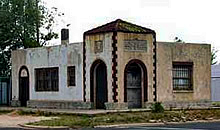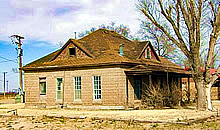Main Menu
Andrews County Data
Andrews County Communities & Places
Genealogy & History Links by USGHN
Important Andrews County Addresses
Sponsors
Andrews County Neighbors
Dawson County, Texas
Ector County, Texas
Gaines County, Texas Genealogy & History Network
Lea County, New Mexico
Martin County, Texas
Midland County, Texas
Winkler County, Texas
Other Websites
Welcome to Andrews County Texas Genealogy & History Network!
Welcome to the Andrews County, Texas Genealogy & History Network. Our purpose is to provide visitors with free resources for genealogical and historical research. To share your genealogy or history information, send an email to txghn@outlook.com and we will happily include it here. For other Texas Counties, visit the Texas Genealogy & History Network state website and go to the appropriate county. Thanks for visiting and good luck with your research! |
|
About Andrews County, Texas...

Andrews, the county seat of Andrews County and the only incorporated town in the county, is on U.S. Highway 385 thirty-four miles north of Odessa. The town, like the county, was named for Richard Andrews, the first man to die in the war for Texas independence in 1835. The town began around 1908 with a general store and a schoolhouse. There were only eighty-seven people living in the county, most of them ranchers. A post office was established in 1909, and Andrews became the county seat in 1910 after a spirited contest against Shafter Lake; in 1911 residents built their first courthouse. In 1903 the Means Memorial Methodist Church became the first Andrews church to organize officially, followed soon after by the Andrews Baptist Church.
Development in Andrews proceeded slowly until 1929, when the Deep Rock Oil Company made the first major strike in the county. As a result of the national economic depression and the slow flow of the oil,  Deep Rock eventually sold its holdings to J. W. Tripplehorn, for $7,500. Tripplehorn brought in the wells J. S. Means No. 1 and R. M. Means No. 1 in 1934, and the pace of development quickened. In 1937 Andrews was incorporated. The town's population, 611 by 1940, did not reflect the increasing importance of the region, for most of the oilmen and their families lived outside of town in company camps. The same year that Tripplehorn's first wells came in, the Andrews County News began publication. A library, established in one room in the county courthouse in 1947, was moved to its own new building in 1967.
Deep Rock eventually sold its holdings to J. W. Tripplehorn, for $7,500. Tripplehorn brought in the wells J. S. Means No. 1 and R. M. Means No. 1 in 1934, and the pace of development quickened. In 1937 Andrews was incorporated. The town's population, 611 by 1940, did not reflect the increasing importance of the region, for most of the oilmen and their families lived outside of town in company camps. The same year that Tripplehorn's first wells came in, the Andrews County News began publication. A library, established in one room in the county courthouse in 1947, was moved to its own new building in 1967.
Oil may have had its greatest local impact on the public school system. A one-room schoolhouse had opened in Andrews in 1907; by 1909 it had twenty-five students. A year later six county school districts were established. In the 1930s the original districts were consolidated into one, based in Andrews. A new high school was built in 1945 and a new middle school in 1954. In 1962 another new high school was built,  and 1973 saw the construction of a new middle school, complete with planetarium. The modern and well-equipped schools reflected the system's reputation as one of the best and the wealthiest in the state.
and 1973 saw the construction of a new middle school, complete with planetarium. The modern and well-equipped schools reflected the system's reputation as one of the best and the wealthiest in the state.
After the opening of new oilfields in 1942, 1943, and 1944, the industry slumped, and by the 1960s most of the oil companies had closed their camps. Left with the choice of diversification or evacuation, many residents stayed on and developed a broader economic base for the town. The population fluctuated during these years, changing from 3,294 in 1950 to 11,135 in 1960, and back to 8,655 in 1970. In 1980 Andrews had a population of 11,061 and 258 businesses, was served by a bus line, two motor freight lines, and a small airport, and had hospitals, a mental health center, and a rest home. Recreational sites included an eighteen-hole golf course and six public parks.
 The county has a total area of 1,501 square miles, of which 1,500.5 square miles is land and 0.5 square miles (0.02%) is water. The population recorded in the 1890 Federal Census was 94. The 2010 census recorded 14,786 residents in the county.
The county has a total area of 1,501 square miles, of which 1,500.5 square miles is land and 0.5 square miles (0.02%) is water. The population recorded in the 1890 Federal Census was 94. The 2010 census recorded 14,786 residents in the county.
Neighboring counties are Gaines County (north), Martin County (east), Midland County (southeast), Ector County (south), Winkler County (southwest), and Lea County, New Mexico (west). The county seat is Andrews. Other communities in the county include Coyote Corner, Fasken, Florey, Frankel City, Old Place Windmills, Shafter Lake, Sixteen Corner Windmill, and Waldon Place Windmill.
Andrews County, Texas Records
Birth Records - The Texas Department of State Health Services has records from 1903 to present. Records for the last 75 years considered private and will only be provided to certain individuals. To obtain current information on who may obtain a record, how to submit a request and an official request form, see the Texas Department of State Health Services website or write to Texas Vital Records, Department of State Health Services, P.O. Box 12040, Austin, TX 78711-2040.
For older birth records you will have to write to the County Clerk of the applicable county. The existence of birth records prior to 1903 will vary widely from county to county. Local historical societies and genealogy collections in local libraries may be able to provide some information.
Death Records - The Texas Department of State Health Services has records from 1903 to present. Records for the last 25 years considered private and will only be provided to certain individuals. To obtain current information on who may obtain a record, how to submit a request and an official request form, see the Texas Department of State Health Services website or write to Texas Vital Records, Department of State Health Services, P.O. Box 12040, Austin, TX 78711-2040.
Marriage Records - The Texas Department of State Health Services can provide a verification letter of marriage for Texas marriages from 1966 to present. This is NOT a marriage license. To obtain a certified copy of a marriage license you must contact the County or District Clerk in the county or district where the marriage took place.
Local historical societies and genealogy collections in local libraries may be able to provide some information.
Divorce Records - The Texas Department of State Health Services can provide a verification letter of divorce for Texas divorces from 1968 to present. This is NOT a copy of the divorce decree. To obtain a certified copy of a copy of the divorce decree you must contact the County or District Clerk in the county or district where the divorce took place.
Local historical societies and genealogy collections in local libraries may be able to provide some information.




